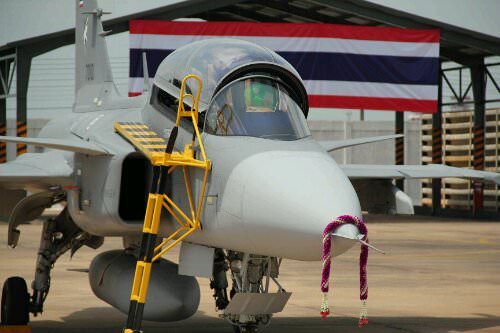Thailand’s JAS 39 Gripen Strategy: A Blueprint for Modern Air Defense and Regional Balance
Thailand’s Gripen Initiative: History, Present, and Future
History
The Royal Thai Air Force (RTAF) has undertaken an ambitious modernization effort over the past two decades, with the decision to adopt the Swedish Saab JAS 39 Gripen fighter jet playing a central role.
In 2007, Thailand’s parliament approved a budget of 34 billion baht (approximately USD 1.1 billion) to replace the aging fleet of Northrop F-5 aircraft. In February 2008, a contract was signed to purchase six Gripen C/D aircraft from Sweden, followed by another six in November 2010. Deliveries were completed between 2011 and 2013. The aircraft were stationed at Surat Thani Air Base, a strategic location covering Thailand’s southern territories and vital maritime routes.
This initiative included not only the aircraft but also an advanced radar platform, the Saab 340 Erieye, and a national data link system connecting all parts of Thailand’s air defense. This integrated system provided the country with a modern and effective defense capability. The relationship between Sweden and Thailand was further deepened through technology transfer and collaboration in training.
Present
In recent years, Gripen has continued to serve as the backbone of Thailand’s air force. However, with aging F-16 aircraft and growing regional tensions, the country has recognized the need for further modernization. In August 2024, RTAF announced plans to replace its older F-16s with the new generation Gripen E/F.
Following a ten-month evaluation, Gripen was chosen over competitors such as Lockheed Martin’s F-16 Block 70/72. The decision was based on Jas 39 Gripen E/F’s lower operating costs, increased operational flexibility, and compatibility with Thailand’s existing defense systems. The plan is to procure four Gripen E aircraft during 2025–2029 with a budget of 19 billion baht (approximately USD 560 million).
Future
Thailand’s future investment in Gripen could mark one of the most significant milestones in the country’s military history. Saab has developed JAS 39 Gripen E/F with a more powerful engine, increased fuel capacity, and advanced systems such as AESA radar and electronic warfare capabilities. Gripen E is designed to counter the most advanced threats and could become a critical part of RTAF’s strategy to address growing tensions in Southeast Asia.
Thailand is likely to benefit from technology transfer and offset agreements included in the Saab deal. This could help strengthen the country’s domestic defense industry and reduce reliance on imports. The plans include expanding the fleet with additional aircraft by 2034.
Regional Context
Asia has seen an increasing arms race, with countries like China, India, and Japan making massive investments in their air forces. In this context, Thailand plays an important role in balancing power dynamics in the region. JAS 39 Gripen E/F’s advanced technology and low costs make it a strategic choice that could help Thailand remain relevant in this complex geopolitical landscape.
Conclusion
With a strong history of collaboration with Saab and Sweden, it is likely that Thailand will continue investing in the Gripen program. The new generation JAS 39 Gripen E/F provides Thailand with an opportunity to modernize its air force and meet future security challenges. At the same time, this investment opens doors to strengthening the country’s domestic defense industry and technological capabilities.
Thailand’s journey with Gripen is not just a story of military modernization but also a testament to how strategic partnerships and innovation can shape a nation’s future in an ever-changing world.
Fact Sheet: Saab JAS 39 Gripen
- Type: Multirole fighter jet
- Manufacturer: Saab AB (Sweden)
- First Flight: December 9, 1988
- In Service Since: 1996 (Swedish Air Force)
Technical Specifications
- Length: 14.1 meters
- Wingspan: 8.4 meters
- Height: 4.5 meters
- Max Speed: Mach 2 (2,200 km/h)
- Range: Approximately 3,000 km with external fuel tanks
Armament
- Internal Cannon: Mauser BK-27 (27 mm)
- External Weapons: Up to 7 hardpoints for air-to-air and air-to-ground missiles, bombs, and external fuel tanks
Advanced Systems
- Radar: PS-05/A or AESA (for JAS 39 Gripen E/F)
- Data Link: National and international links for advanced communication
- Electronic Warfare: Integrated countermeasure systems
Operators:
- Sweden, Brazil, Thailand, South Africa, Czech Republic, Hungary
Unique Features:
The Gripen is renowned for its low operating costs, high maneuverability, and advanced technology, making it one of the most cost-effective fighter jets in the world.
Saab JAS 39 Gripen – https://en.wikipedia.org/wiki/Saab_JAS_39_Gripen
ยาส 39 – https://th.wikipedia.org/wiki/ยาส_39
Gripen – controlling the battlespace in a changing world – https://www.saab.com/products/air/fighter-systems
Video
news via inbox
stay informed







